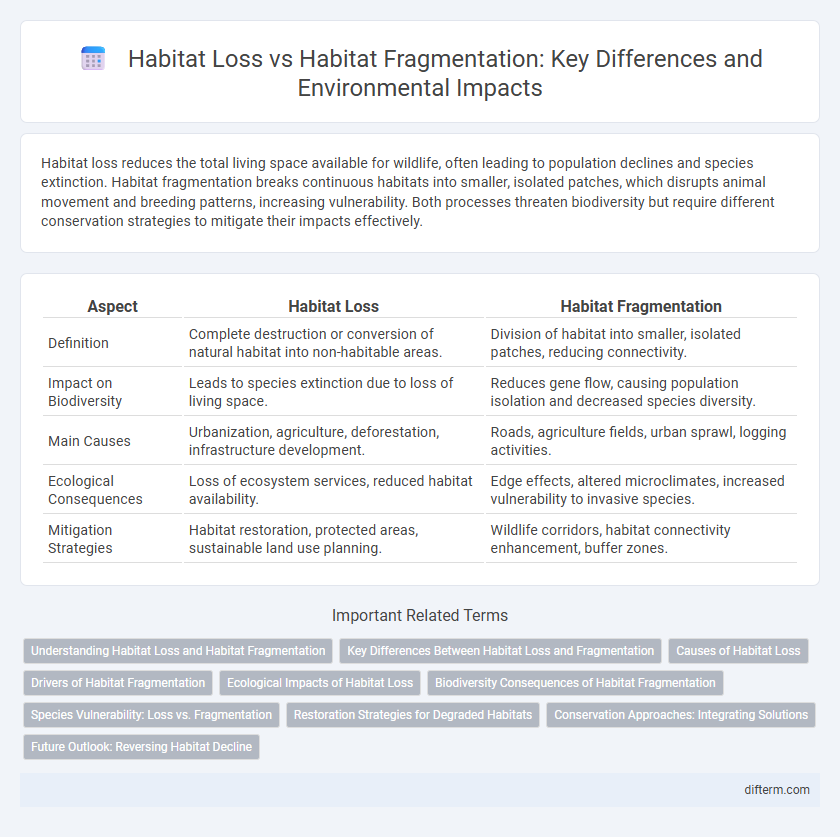Habitat loss reduces the total living space available for wildlife, often leading to population declines and species extinction. Habitat fragmentation breaks continuous habitats into smaller, isolated patches, which disrupts animal movement and breeding patterns, increasing vulnerability. Both processes threaten biodiversity but require different conservation strategies to mitigate their impacts effectively.
Table of Comparison
| Aspect | Habitat Loss | Habitat Fragmentation |
|---|---|---|
| Definition | Complete destruction or conversion of natural habitat into non-habitable areas. | Division of habitat into smaller, isolated patches, reducing connectivity. |
| Impact on Biodiversity | Leads to species extinction due to loss of living space. | Reduces gene flow, causing population isolation and decreased species diversity. |
| Main Causes | Urbanization, agriculture, deforestation, infrastructure development. | Roads, agriculture fields, urban sprawl, logging activities. |
| Ecological Consequences | Loss of ecosystem services, reduced habitat availability. | Edge effects, altered microclimates, increased vulnerability to invasive species. |
| Mitigation Strategies | Habitat restoration, protected areas, sustainable land use planning. | Wildlife corridors, habitat connectivity enhancement, buffer zones. |
Understanding Habitat Loss and Habitat Fragmentation
Habitat loss occurs when natural environments are completely destroyed or converted for human use, leading to the disappearance of ecosystems essential for biodiversity. Habitat fragmentation divides continuous habitats into smaller, isolated patches, disrupting species movement and genetic exchange without entirely removing the environment. Both processes threaten wildlife by altering living conditions, but habitat fragmentation often exacerbates the negative effects of habitat loss by increasing edge effects and reducing habitat connectivity.
Key Differences Between Habitat Loss and Fragmentation
Habitat loss refers to the complete destruction or conversion of natural environments, resulting in a permanent reduction of living space for wildlife, while habitat fragmentation involves the breaking up of continuous habitats into smaller, isolated patches that disrupt species movement and genetic flow. Habitat loss typically leads to a total decline in biodiversity as species lose essential resources, whereas fragmentation mainly causes edge effects and population isolation, increasing vulnerability to extinction. Understanding these key differences is critical for designing effective conservation strategies and mitigating the impacts on ecosystems.
Causes of Habitat Loss
Habitat loss primarily results from deforestation, agricultural expansion, and urban development, which directly eliminate natural environments needed for wildlife survival. Industrial activities and infrastructure projects lead to large-scale destruction of ecosystems, reducing biodiversity and disrupting ecological balance. Pollution and climate change exacerbate habitat degradation, intensifying the loss of critical habitats for numerous species.
Drivers of Habitat Fragmentation
Habitat fragmentation is primarily driven by human activities such as urban development, agriculture expansion, and infrastructure construction, which divide continuous natural landscapes into smaller, isolated patches. This process creates edge effects that alter microclimates and increase vulnerability to invasive species and predation. Unlike habitat loss, which eliminates habitats entirely, fragmentation reduces connectivity, disrupting wildlife movement and gene flow essential for biodiversity maintenance.
Ecological Impacts of Habitat Loss
Habitat loss leads to a significant decline in biodiversity by directly eliminating the living spaces essential for various species' survival, disrupting food chains and ecosystem services. This irreversible reduction in habitat area causes species populations to become isolated, increasing vulnerability to extinction and reducing genetic diversity. Furthermore, habitat loss exacerbates climate change effects by diminishing natural carbon sinks like forests and wetlands, altering local and global ecological balance.
Biodiversity Consequences of Habitat Fragmentation
Habitat fragmentation leads to the division of ecosystems into smaller, isolated patches, significantly reducing biodiversity by limiting species movement and gene flow. Fragmented habitats increase edge effects, exposing native species to invasive species, altered microclimates, and higher predation rates, which further threaten population viability. This disruption of ecological connectivity ultimately causes decreased species richness, local extinctions, and compromised ecosystem resilience.
Species Vulnerability: Loss vs. Fragmentation
Species vulnerability escalates sharply with habitat loss as entire ecosystems are eradicated, drastically reducing available resources and breeding grounds essential for survival. Habitat fragmentation, while not eliminating ecosystems, isolates populations into smaller, disconnected patches, increasing inbreeding, reducing genetic diversity, and impeding species' ability to migrate or adapt to environmental changes. Both habitat loss and fragmentation critically threaten biodiversity, but fragmentation uniquely challenges species resilience through landscape isolation and altered ecological dynamics.
Restoration Strategies for Degraded Habitats
Restoration strategies for degraded habitats prioritize reforestation, native species reintroduction, and controlling invasive species to counteract both habitat loss and fragmentation. Implementing ecological corridors enhances connectivity between fragmented patches, promoting genetic diversity and species migration. Soil enrichment and hydrological restoration further support ecosystem recovery and resilience against environmental stressors.
Conservation Approaches: Integrating Solutions
Conservation approaches must prioritize both habitat loss prevention and habitat fragmentation mitigation to maintain biodiversity effectively. Restoration projects that reconnect fragmented landscapes enhance wildlife corridors, promoting species mobility and genetic diversity. Integrating land-use planning with protected area expansion supports sustainable ecosystem functions and resilience against environmental disturbances.
Future Outlook: Reversing Habitat Decline
Reversing habitat decline requires integrated strategies targeting both habitat loss and fragmentation by restoring continuous ecosystems and expanding protected areas to enhance biodiversity resilience. Advancements in ecological restoration techniques and landscape connectivity models are critical for rebuilding degraded habitats and re-establishing wildlife corridors, which support gene flow and species survival. Future success depends on global commitment to sustainable land use policies, incorporating climate adaptation measures to safeguard vulnerable ecosystems from further degradation.
habitat loss vs habitat fragmentation Infographic

 difterm.com
difterm.com